

Moons, Maps & Animations
In this section you'll find images of the Jovian Moons, Cylindrical projection maps of Jupiter, and animations of the Planet.
Jupiter rotation movie April 19-20th, 2006.
Jupiter rotation movie April 25-26th, 2005.
Ganymede occulted by Jupiter's shadow. April 16th, 2006.
Jupiter polar map. April 19-20th, 2006.
Jupiter projection map. April 19-20th, 2006.
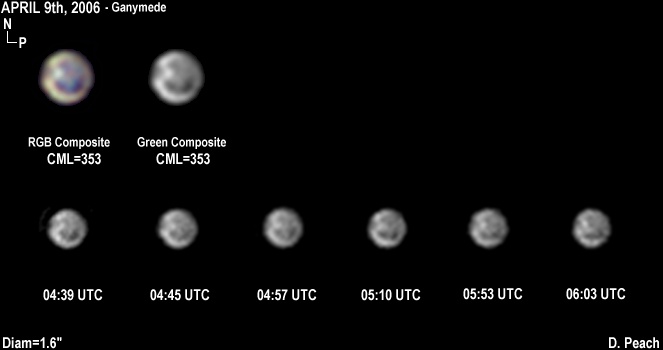
Ganymede. April 9th, 2006.
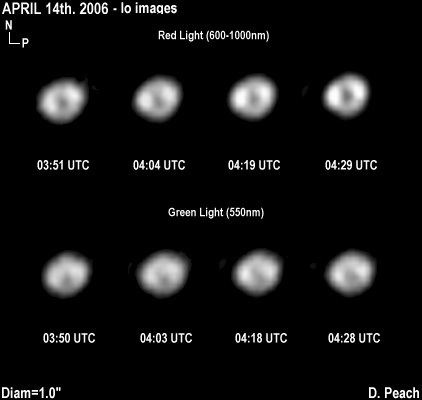
Io. April 14th, 2006.
Voyager style time lapse animation. One of the great achievements of the trip was to produce this short voyager style time lapse of the entire planet, showing the movements of the currents and jetstreams. The first time this has been achieved from the ground, and the only time i have seen such an animation that wasn't spacecraft produced :-). 9.25" Schmidt Cassegrain. Lumenera LU075M CCD camera.
The entire face of Jupiter. A cylindrical projection map of Jupiter showing the entire Planet on April 25-26th, 2005. 9.25" Schmidt Cassegrain. Lumenera LU075M CCD camera.
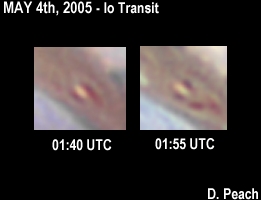
Io in Transit, May 4th, 2005. . Again showing Io in transit across the NEB with surface detail - note its bright equator and dark polar areas, also seen on April 27th. 9.25" Schmidt Cassegrain. Lumenera LU075M CCD camera.
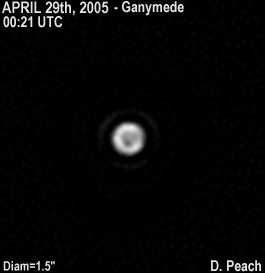
Ganymede on April 29th, 2005 .Ganymede with surface detail. 9.25" Schmidt Cassegrain. Lumenera LU075M CCD camera.
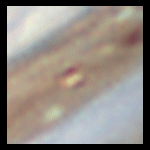
Io in Transit, April 27th, 2005. . An animation showing Io in transit across the NEB with surface detail. 9.25" Schmidt Cassegrain. Lumenera LU075M CCD camera.
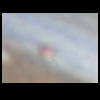
Europa in transit, April 25th, 2005. Europa in transit across the North Tropical Zone showing surface detail - the first time this has ever been seen in amateur imagery. 9.25" Schmidt Cassegrain. Lumenera LU075M CCD camera.
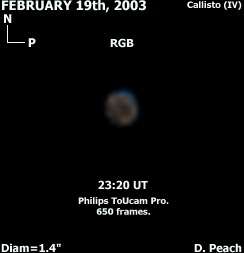
Dark Callisto. This image shows Jupiter's dark cratered moon Callisto.
12" Meade Schmidt Cassegrain @ F31. SBIG ST-5c camera.
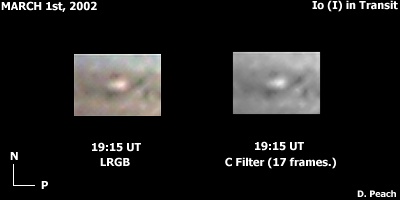

Io in Transit. When Jupiter's volcanic moon Io passes through transit, its possible to see details on its surface as the above views show. Io's Equatorial region is much brighter than its polar regions, well seen in Voyager imagery.
12" Meade Schmidt Cassegrain @ F31. SBIG ST-5c & ToUcam Pro cameras.


Mutual Phenomena. Every several years it is possible for the Jovian moons to eclipse each other as the Earth is aligned with Jupiter's equatorial plane. These images show a close pass of Ganymede and Io, and a partial eclipse of Callisto by Io.
12" Meade Schmidt Cassegrain @ F31. SBIG ST-5c camera.
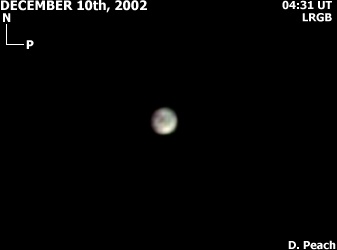
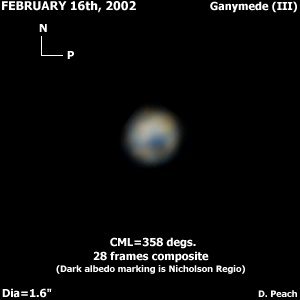
Two views of Ganymede. These two views of Ganymede show some of the surface markings confirmed in Voyager maps. The view at left shows Galileo Region, while at right Nicholson Regio. Both these features are notable dark areas of the surface of Ganymede.
12" Meade Schmidt Cassegrain @ F31. SBIG ST-5c camera.
Click for full size images.
The entire face of Jupiter in January 2003. A cylindrical projection map of the entire face of Jupiter on January 28-29th, 2003. Note that the North Temperate Belt has almost totally disappeared compared to the view below.
12" Meade Schmidt Cassegrain @ F31. SBIG ST-5c camera.
Click for full size images.
The entire face of Jupiter in December 2002. A cylindrical projection map of the entire face of Jupiter on December 14-15th, 2002.
12" Meade Schmidt Cassegrain @ F31. SBIG ST-5c camera.
Click for full size images.
The entire face of Jupiter in February 2002. A cylindrical projection map of the entire face of Jupiter on February 15-16th, 2002.
12" Meade Schmidt Cassegrain @ F31. SBIG ST-5c camera.
Click for full size animation
The fast moving Equatorial Zone. Just two days apart showing exactly the same longitudes, this animation shows how fast features in the Jovian equatorial zone move in relation to the rest of the Planet.
12" Meade Schmidt Cassegrain @ F22. SBIG ST-5c camera.
Click for full size animation
Currents & Jetstreams. In this voyager style animation at high resolution, showing the exact same longitudes 9 days apart. This animation well illustrates the different speeds and directions at which features move on Jupiter. Note the two small anti-cyclones at the top of the image just miss each other as one speeds past the other. Also note the large barge on the NEBn remains stationary.
12" Meade Schmidt Cassegrain @ F22. SBIG ST-5c camera.
Click for full size animation
180° of rotation. Despite poor seeing on this occasion on October 17-18th, 1999 around half the Planet was imaged.
12" Meade Schmidt Cassegrain @ F22. SBIG ST-5c camera.
Click for full size animation
A fast changing world. Almost exactly one month later on October 6th, 1999 the view below showing exactly the same hemisphere, its apparent just how much has chnaged. Note the small bright SSTB white oval has moved in relation to the GRS. Also Ovals BE and FA are much closer to the GRS in this animation.
12" Meade Schmidt Cassegrain @ F22. SBIG ST-5c camera.
Click for full size animation
The Great Red Spot crosses the disk. In this animation from September 5th, 1999, the GRS is seen moving across the Planet. All of the animations are great illustrations of how fast Jupiter rotates (this animation covers about 2hrs.)
12" Meade Schmidt Cassegrain @ F22. SBIG ST-5c camera.
Copyright © 2003-2004. www.damianpeach.com. No material used within this website may be used, amended or distributed without the consent of the webmaster.